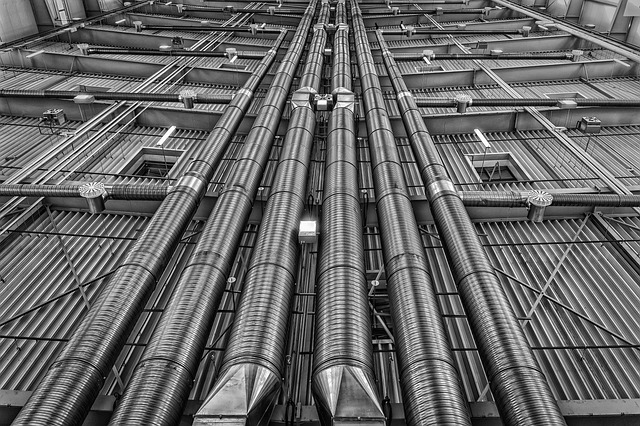Industrial air curtains are specialized climate control solutions that regulate indoor temperature and enhance worker productivity in various industrial settings, particularly in cold storage facilities. These devices act as powerful air barriers, minimizing energy losses and ensuring product quality and safety by sealing off entrances and large openings. By addressing temperature extremes, they boost employee comfort, focus, and performance while offering versatile, efficient alternatives to traditional HVAC systems. Future developments aim to create smarter, adaptable barriers with advanced materials and real-time data adjustments for precise temperature regulation across diverse sectors.
Industrial air curtains are revolutionizing workplace comfort by tackling a often-overlooked aspect of employee well-being: indoor temperature stability. In an era where productivity hinges on optimal conditions, these innovative solutions mitigate the impact of fluctuating temperatures, enhancing worker morale and performance. This article explores the multifaceted benefits of industrial air curtains, from their fundamental role in climate control to inspiring case studies and glimpses into future technological advancements.
- Understanding Industrial Air Curtains: Their Role and Benefits
- The Impact of Temperature Fluctuations on Worker Productivity
- How Air Curtains Stabilize Indoor Climate
- Case Studies: Success Stories in Implementing Air Curtains
- Future Trends: Innovations in Air Curtain Technology for Improved Workplace Comfort
Understanding Industrial Air Curtains: Their Role and Benefits

Industrial air curtains are specialized solutions designed to regulate indoor temperature and create a comfortable working environment in various industrial settings. These innovative devices play a pivotal role in enhancing worker productivity by addressing one of the most overlooked aspects of workplace comfort: climate control. In harsh climates or environments with significant temperature variations, maintaining a stable internal temperature can be challenging, often leading to discomfort and decreased employee morale.
These air curtains act as powerful industrial air barriers, effectively sealing off warehouse entrance protection, heavy-duty manufacturing door systems, and large openings in factories. By preventing external air from entering and interior air from escaping, they facilitate the implementation of efficient industrial HVAC (heating, ventilation, and air conditioning) systems. This is particularly beneficial for cold storage facilities where keeping products at specific temperatures is crucial, ensuring product quality and safety. The use of these curtains also minimizes energy losses, contributing to cost savings and environmental sustainability in manufacturing processes.
The Impact of Temperature Fluctuations on Worker Productivity

Temperature fluctuations in industrial settings can significantly impact worker productivity and overall job satisfaction. Extreme heat or cold can cause discomfort, leading to decreased focus and reduced efficiency among employees. Workers may experience fatigue, and in extreme cases, heatstroke or hypothermia, resulting in increased absenteeism and potential safety hazards. This is particularly concerning in industries with high-energy operations, such as manufacturing and warehousing, where tasks require constant focus and physical exertion.
Industrial air curtains, also known as heavy-duty air barriers, offer a solution to mitigate these issues. By creating a controlled climate at warehouse entrances, factory doors, or loading docks, these air curtains ensure that temperature fluctuations are minimized, providing a comfortable environment for workers. This is especially crucial in cold storage facilities where maintaining a consistent temperature is essential for product quality and employee well-being. Compared to traditional HVAC systems, industrial air curtains provide targeted protection, effectively sealing large openings while allowing easy access, making them ideal for various manufacturing door systems.
How Air Curtains Stabilize Indoor Climate

Industrial air curtains play a pivotal role in stabilizing indoor climate within manufacturing and warehousing spaces. These advanced systems are designed to act as robust industrial air barriers, effectively controlling the flow of external air at large openings like warehouse entrances or factory doors. By doing so, they prevent the intrusion of outside weather conditions, such as extreme temperatures, into the controlled interior environment.
In cold climates, heavy-duty air curtains keep frigid air at bay, while in hot regions, they safeguard against the entrance of warm exterior air. This prevents the need for excessive use of industrial HVAC systems and factory entrance heating, leading to significant energy savings. The strategic deployment of these air curtains at loading docks and cold storage areas also ensures optimal conditions for handling temperature-sensitive goods, enhancing overall worker comfort and efficiency in demanding industrial settings.
Case Studies: Success Stories in Implementing Air Curtains

In various industries, the implementation of industrial air curtains has led to notable success stories in improving worker comfort and productivity. For instance, a leading manufacturing company faced challenges with extreme temperature fluctuations at their warehouse entrance, which affected employee morale and efficiency. After installing heavy-duty air curtains, they witnessed a significant decrease in cold drafts, resulting in a more comfortable work environment. This simple yet effective solution not only enhanced the overall atmosphere but also reduced downtime caused by weather conditions.
Another case involves a large cold storage facility where maintaining a consistent temperature was crucial. By utilizing advanced industrial air barriers at loading docks, they achieved remarkable climate control. The air curtains effectively sealed large openings, preventing hot or cold external air from penetrating the building. This not only stabilized the indoor temperature but also optimized their industrial HVAC systems, leading to substantial energy cost savings without compromising on worker comfort.
Future Trends: Innovations in Air Curtain Technology for Improved Workplace Comfort

As technology advances, the future of industrial air curtain development promises enhanced comfort and efficiency for workers in various sectors. Innovations are focused on creating smarter, more adaptable industrial air barriers that can dynamically respond to changing environmental conditions. These advancements will ensure optimal performance, even in challenging settings like heavy-duty manufacturing door systems or large openings in warehouses.
Imagine industrial climate control solutions that automatically adjust based on real-time data, providing precise temperature regulation at factory entrances and loading docks. New designs could incorporate advanced materials for improved durability, especially when protecting sensitive cold storage areas. Additionally, integration with industrial HVAC systems may enable the curtains to work in harmony with existing infrastructure, offering seamless and effective solutions for worker comfort and warehouse entrance protection.
Industrial air curtains have emerged as a game-changer in enhancing worker comfort and productivity. By mitigating temperature fluctuations, these innovative solutions stabilize indoor climate, fostering a safer and more efficient workspace. Case studies demonstrate their effectiveness across various industries, and ongoing technological advancements promise even greater benefits in the future. Investing in industrial air curtains is a strategic move to revolutionize workplace comfort, ultimately driving operational excellence.






